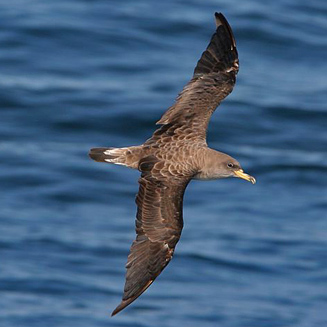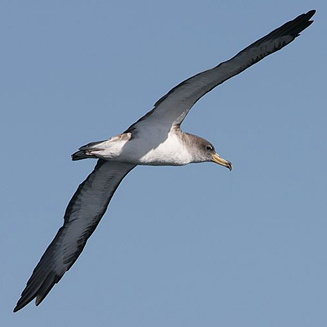|
Calonectris diomedea (Cory's
shearwater)
Geelbekpylstormvoël [Afrikaans]; Kuhl-pijlstormvogel
[Dutch]; Puffin cendré [French]; Gelbschnabel-sturmtaucher [German]; Cagarra
[Portuguese]
Life
> Eukaryotes >
Opisthokonta
> Metazoa (animals) >
Bilateria >
Deuterostomia > Chordata >
Craniata > Vertebrata (vertebrates) > Gnathostomata (jawed
vertebrates) > Teleostomi (teleost fish) > Osteichthyes (bony fish) > Class:
Sarcopterygii (lobe-finned
fish) > Stegocephalia (terrestrial
vertebrates) > Tetrapoda
(four-legged vertebrates) > Reptiliomorpha > Amniota >
Reptilia (reptiles) >
Romeriida > Diapsida > Archosauromorpha > Archosauria >
Dinosauria
(dinosaurs) > Saurischia > Theropoda (bipedal predatory dinosaurs) >
Coelurosauria > Maniraptora > Aves
(birds) > Order: Ciconiiformes
> Family: Procellariidae
 |
 |
| Cory's shearwater, offshore from Cape Town, South Africa. [photo
Trevor Hardaker ©] |
Cory's shearwater, offshore from Cape Town, South Africa. [photo Trevor Hardaker ©] |
Distribution and habitat
Breeds on islands in the Mediterranean and north-west
Atlantic Ocean, after which it heads through the Atlantic Ocean, to the western
Indian Ocean. A common summer visitor to southern Africa, while especially off
the western and southern coast, while more scarce off the south-eastern coast.
Movements and migrations
Present at its breeding colonies from late
February to October and November, while most common in southern
African waters in the period from November-May.
Food
It mainly eats fish, supplemented with shrimps, squid and
cuttlefish, doing most of its foraging by catching prey from the water surface
or plunge-diving up to a depth of about five metres. It also regularly feeds in
association with dolphins, toothed whales, gamefish and dolphins, catching prey
that they disturb. The following food items have been recorded
in its diet:
- fish
- Scomberesox saurus (Sauries)
- Lampanyctodes hectoris (lanternfish)
- Maurolicus muelleri (Lightfish)
- Engraulis encrasicolus (Anchovies)
- invertebrates
- Squilla armata (mantis shrimps)
- Taonius (squid)
- Sepia (cuttlefish)
Threats
Not threatened, although killed on longlines and by
introduced predators at colonies.
References
-
Hockey PAR, Dean WRJ and Ryan PG 2005. Roberts
- Birds of southern Africa, VIIth ed. The Trustees of the John Voelcker
Bird Book Fund, Cape Town.
|
